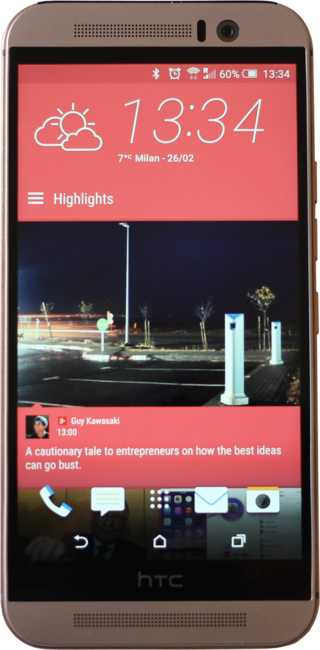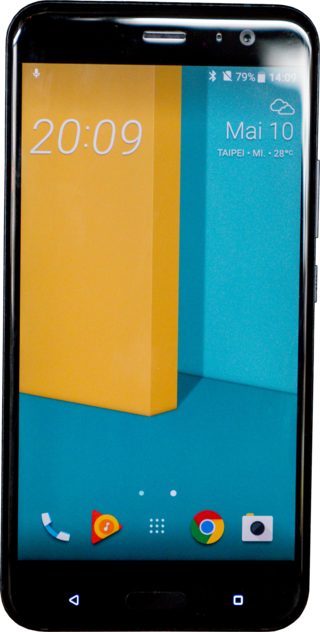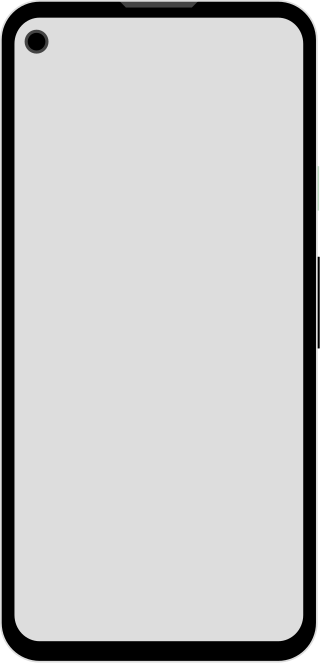
A smartphone is a mobile device that combines the functionality of a traditional mobile phone with advanced computing capabilities. It typically has a touchscreen interface, allowing users to access a wide range of applications and services, such as web browsing, email, and social media, as well as multimedia playback and streaming. Smartphones have built-in cameras, GPS navigation, and support for various communication methods, including voice calls, text messaging, and internet-based messaging apps.

HTC Magic is an Android smartphone designed and manufactured by HTC. It is HTC's second Android phone after HTC Dream, HTC's first touch-only flagship Android device and the second Android phone commercially released, as well as the first Android phone without a keyboard.

The Samsung Galaxy S series is a line of flagship Android smartphone and tablet computer produced by Samsung Electronics. In conjunction with the foldable Galaxy Z series, the lineup serves as Samsung's flagship smartphone lineup.

The Sony Xperia Z is an Android-based smartphone by Sony. Announced at CES 2013 the phone was officially released on 9 February 2013 in Japan and 1 March 2013 in Singapore and the UK. It was released in the U.S months later. The Xperia Z was initially shipped with the Android 4.1.2 operating system. The smartphone has Ingress Protection Ratings of IP55 and IP57. It also contains a 13.1 MP Exmor RS camera sensor, and the screen of the phone consists of a TFT 1920x1080 display, with 441 ppi. It would be the first smartphone in the Sony Xperia Z series, continuing all the way up to the Xperia Z5.
The Huawei Ascend Mate is an Android phablet smartphone manufactured by the Chinese telecommunications company Huawei. The Ascend Mate was officially unveiled at the 2013 International CES in Las Vegas, and was released in China in February 2013 with an international release following in March. It is the first device in the Huawei Mate series.
The HTC Rhyme is a multi-touch, slate-format Android 2.3 smartphone designed and produced by HTC. The Rhyme was released in the United States exclusively by Verizon Wireless on September 22, 2011, with releases in Asia and Europe beginning in October 2011. The Rhyme is a mid-range smartphone, distinguished by its use of an updated HTC Sense 3.5 user experience, and a selection of bundled accessories; such as a charging dock, wireless speakers, and an LED "charm" that can be used as a notification light. While it was not explicitly marketed as such by HTC, the Rhyme was primarily developed and targeted towards women.

The HTC One (M8) is an Android or Windows smartphone manufactured and marketed by HTC. Following a number of leaks that occurred during the months prior, the device was officially unveiled in a press conference on March 25, 2014, and released the same day by Verizon Wireless at retail, and by other Canadian and United States carriers for online orders prior to its wider retail availability in mid-April.

The HTC One M9 was an Android smartphone manufactured and marketed by HTC. The M9 was officially unveiled in a press conference at Mobile World Congress on March 1, 2015, and it was released worldwide on April 10, 2015. It is the successor to HTC One (M8). Now there are many other models and new devices included into this HTC.

The HTC 10 is an Android smartphone manufactured and marketed by HTC. It was announced on April 12, 2016.

Moto Z is an Android smartphone developed by Motorola Mobility. Unveiled on June 9, 2016, as its flagship model for the year, the Moto Z is distinguished by the "Moto Mods" technosystem which allows case accessories to be magnetically attached to the device to provide additional functionality. The Moto Z was later joined by the more rugged Moto Z Force of which shares most of the same internals as the former, and the mid-range Moto Z Play with downgraded specifications, all three devices being compatible with the modular system.
The Pixel and Pixel XL are a pair of Android smartphones designed, developed, and marketed by Google as part of the Google Pixel product line, succeeding the Nexus line of smartphones. They were officially announced on October 4, 2016 at the Made by Google event and released in the United States on October 20. On October 4, 2017, they were succeeded by the Pixel 2 and Pixel 2 XL.

The HTC U11 is an Android smartphone manufactured and sold by HTC as part of the HTC U series. It was announced on 16 May 2017 and succeeds the HTC 10 smartphone. In the United States, the HTC U11's major carrier is Sprint; however, it is also compatible with unlocked carriers, such as AT&T, T-Mobile, and Verizon.

The LG V30 is an Android phablet manufactured by LG Electronics as part of the LG V series. Unveiled on 31 August 2017 as the successor to the LG V20, the V30 forgoes the V20's secondary display for a "floating bar" which has nearly the same functions as the second display. It still features quad DACs for improved audio.
The Nokia 8 Sirocco (TA-1005) is a high-end smartphone by HMD Global, running the Android One variant of Android. It was introduced at MWC in February 2018, and named after the Nokia 8800 Sirocco. The successor of the Nokia 8 Sirocco is the Nokia 9 PureView.

The Samsung Galaxy S10 is a line of Android-based smartphones manufactured, released and marketed by Samsung Electronics as part of the Samsung Galaxy S series. The Galaxy S10 series is the tenth generation of the Samsung Galaxy S, its flagship line of phones next to the Note models, which is also the 10th anniversary of the Galaxy S. Unveiled during the "Samsung Galaxy Unpacked 2019" press event held on 20 February 2019, the devices started shipping in certain regions such as Australia and the United States on 6 March 2019, and internationally on 8 March 2019.

Huawei Mate 20 is a line of Android phablets produced by Huawei, which collectively succeed the Mate 10 as part of the Huawei Mate series. The flagship models, the Mate 20 and Mate 20 Pro, were unveiled on 20 July 2018 at a press conference in London.

Huawei P30 is a line of Android-based smartphones manufactured by Huawei. Unveiled on 26 March 2019, they succeed the Huawei P20 in the company's P series line.

The Pixel 4a and Pixel 4a (5G) are a pair of Android smartphones designed, developed, and marketed by Google as part of the Google Pixel product line. They collectively serve as mid-range variants of the Pixel 4 and Pixel 4 XL. The Pixel 4a was announced on August 3, 2020 via a press release, while the Pixel 4a (5G) was announced on September 30, 2020 at the "Launch Night In" event.

The Pixel 5a, also known as the Pixel 5a with 5G, is an Android smartphone designed, developed, and marketed by Google as part of the Google Pixel product line. It serves as a mid-range variant of the Pixel 5. It was officially announced on August 17, 2021 via a press release and released on August 26.
The iPhone's hardware is designed by Apple Inc. Apple directly sub-contracts hardware production to external OEM companies, maintaining a high degree of control over the end product.













